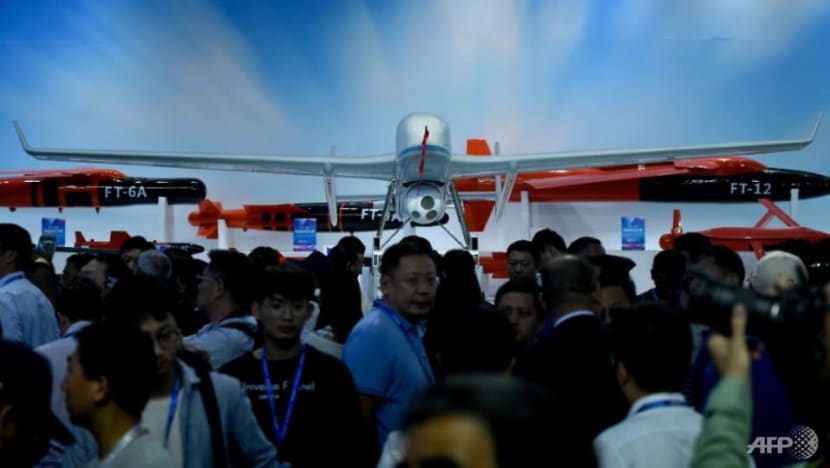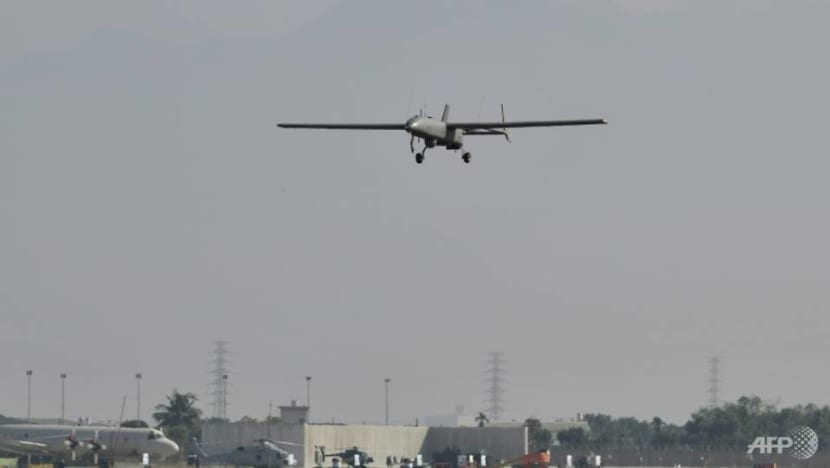commentary Commentary
Commentary: China’s cheap drones are finally taking off, with many uses and huge implications
The proliferation of drones China produces for commercial use and military operations could alter the geostrategic balance, says Defense News’ Mike Yeo.

China's drones are now flying in the Middle East, as Beijing is more willing than the United States to sell its military UAVs to other nations. (Photo: AFP/WANG ZHAO)
MELBOURNE: Think about China and drones and DJI comes to mind.
The university dormitory project-turned-world’s biggest commercial drone company is now the name on everyone’s lips with its line of drones used by hobbyists to large business operations and everyone else in between.
Founded in 2006, DJI, together with companies like Yuneec and PowerVision, have made China the largest manufacturer of drones in the world, mirroring other Chinese-made products’ virtual dominance of much of the world’s consumer markets and gaining a reputation for being good enough or better, at a competitive price point.
These have found their way into a wide array of applications and everyday tasks, including the spraying of pesticides on pecan farms in hilly Zhejiang and firefighting.
An impressive demonstration in Chongqing in early 2020 showcased multiple heavy-duty quadcopter drones lifting hoses and other firefighting equipment and assisting in putting out a fire in a high-rise building.
Drones are expanding the locus of possibilities in China, allowing farmers to cultivate previously inaccessible land, while reducing human exposure to chemicals, and doing away with the need for firefighters to climb long flights of stairs to tackle building blazes in speeding up time-critical rescue missions.
READ: Commentary: Fighter jets get attention but defending Singapore against rockets and drones require very different tools
BRANCHING INTO COMMERCIAL, WEATHER MONITORING USES
Going beyond commercially available drones, China is also investing effort into developing more sophisticated drones for commercial and military purposes in fresh situations.
These include research into climate systems such as typhoons, where drones operate at high altitudes, complicated geographic and extreme weather conditions.
These operations can make a sum difference when cloud-seeding flights commissioned by the Gansu provincial government have increased rainfall in the Qilian Mountains in early 2021, a region plagued by water shortages since late 2020.

Earlier in August 2020, the China Meteorological Administration had also reported conducting four high-altitude drone flights with specialised meteorological equipment to carry out upper-air meteorological experiments from Boao Airport in Hainan Island in southern China.
These flights culminated in a mission where 30 sensors were dropped into a typhoon to carry out three-dimensional scans of the peripheral cloud system.
The experiment provided real-time data of the temperature, humidity, air pressure and wind direction, assisting in the country’s research into typhoon formation and prediction.
READ: Commentary: 2021 has already seen the wettest and driest months in decades. Is Singapore prepared for more?
EXPANSION OF DRONE USE IN MILITARY OPERATIONS
Photos released by Chinese state media of the aforementioned drones show that both appear to be indigenous Chinese drone designs originally meant for China’s military.
This comes as little surprise when the People’s Liberation Army (PLA) has put into service several different types of drones, mostly for surveillance tasks, in recent years.
Unlike consumer-grade drones, the military employs these more sophisticated drones in complex missions, at higher altitudes, requiring them to stay aloft for longer duration, measured in days in some instances.

They are powered by internal combustion engines instead of the batteries that run consumer drones, and are fitted with security features such as electronic shielding to reduce the likelihood of being electronically jammed or hacked.
The systems used by the PLA include the Chengdu Aircraft Industry Group’s Wing Loong I and II and the China Aerospace Science and Technology Corporation’s CH-5 medium-altitude, long-endurance systems, as well as the CAIG Cloud Shadow and Guizhou WZ-7 Soar Dragon for high-altitude work.
There are a handful designed strictly for military use. The PLA Navy uses the Harbin BZK-005 medium-altitude drone in surveillance, including at bases in Hainan and Chinese-held islands in the disputed South China Sea.
Both the CH-5 and Wing Loong drones can be armed with small guided bombs and missiles. The latter has seen combat service in Libya, Yemen and Nigeria, with the drones operated by the United Arab Emirates and Saudi Arabia respectively.
But many, like the Wing Loong II and Cloud Shadow used respectively in cloud seeding and typhoon observation missions, have dual civilian and military uses.
READ: Commentary: They already have jet bombers and super missiles. Will Chinese fighter jets be more powerful than America’s soon?
Drones are also used in construction, mining, delivery and media but most remain largely experimental. For this reason, accurate estimates of the commercial drone market are hard to come by.
CHINA PRESSES ON WITH DEVELOPING ADVANCED DRONES
Like several other nations including the United States, China continues to develop newer, more advanced drones for its military.
At least two of these types are in service, having been put on display at the 2019 military parade in Beijing commemorating the 70th Anniversary of the founding of the People’s Republic of China.
These designs eschew the propeller-driven engines powering older drones, like the Wing Loong, using instead, rocket engines for improved speed, lift time and other performance parameters.

The first of these is the Hongdu GJ-11, a stealthy, jet-powered flying wing design believed to have an internal weapons bay and expected to conduct both surveillance and attack missions.
The other is the Chengdu WZ-8, believed to be an air launched drone, powered by a pair of rocket engines to cruising speeds more than three times the speed of sound at a 30km altitude.
The WZ-8 is expected to carry out high-speed strategic reconnaissance of heavily defended airspace.
The drone can be launched by the PLA air force’s Xi’an H-6 bombers, with WZ-8s at the 2019 parade bearing serial numbers suggesting assignment to a bomber regiment based at Anqing, east of Shanghai, putting both Taiwan and Japan well within range.
The PLA Navy is also believed to be looking at high-performance drones to operate off its third aircraft carrier, currently under construction at a shipyard in Shanghai.
Satellite photos have captured an unknown drone apparently being readied for launch from a land-based catapults similar to those expected to be fitted to the aircraft carrier being built, although further details about such a carrier-borne drone have not been publicised.
READ: Commentary: Trump’s playbook on China in the South China Sea has some lessons for the Biden administration
A GROWING DRONE EXPORT MARKET
Some of these Chinese military grade drones have made their way into China’s growing defence export market. China has also sold similar systems to countries like Algeria, Indonesia and Iraq. The latter having used these against Islamic State militants still operating in that country.
China has performed well in the export of armed drones, having penetrated into markets that have traditionally selected Western systems including Indonesia, Jordan, Saudi Arabia and the UAE in addition to China’s traditional arms export markets in places like Africa and Asia.
This is due in part to US refusal to sell armed drones to anyone other than its closest allies.

Europe’s drone industry is still in its infancy. Drones from Israel, whose own industry has successfully developed and exported products, remain less of an option to Muslim countries. Turkish drones are good alternatives, but Chinese drones have made comparatively more export inroads.
The result has been a proliferation of drones among militaries all over the world, with low cost of ownership and use compared to traditional aircraft and other offensive weaponry being key selling points along with their ability to stay in the air for long periods to conduct surveillance and precision-attack missions.
The self-imposed ban on wider drone exports by the US was lifted by the Trump Administration last October following a reinterpretation of the Missile Technology Control Regime (MTCR) rules, which has seen some US aligned operators of Chinese drones reconsider their options.
Jordan has put its CH-4 drones (predecessor to the CH-5) up for sale for undisclosed reasons, while the UAE quickly requested (and got approval) to buy the American Reaper armed drone in the dying days of the Trump Administration, fuelling speculation Chinese drones are not of a standard operators of Western systems have come to expect.
READ: Commentary: Fighter jet sales to Taiwan and the complex US-China balance of power
As I have written before, China operates a two-tier arms export system, with arms for exports of a lower standard than what the PLA operates.
The secrecy that surrounds many weapons used by the PLA also means that the outside world knows very little about what they can or cannot do.
But that would not necessarily be an indictment of the the PLA’s own advanced drones even if they are still likely to still lag in terms of reliability and sophistication compared to their American equivalents.
It would be interesting to see how China’s growing influence in the drone market, which are becoming a critical part of low-intensity, non-conventional warfare among states with low defence budgets and day-to-day civilian operations augmenting limited manpower, will alter the geostrategic balance.
READ: Commentary: Was tough talk on South China Sea to boost US export of drones to Southeast Asia?
It would be a tell-tale sign if more countries chose Chinse drones over Israeli, American or Turkish drones based on factors apart from cost or political considerations.
There is no doubt that the market for drones, both civilian and military, will only grow going forward.
Their performance and capabilities will improve in line with customer demands, particularly in the latter market.
The market potential will also draw in other players, as evidenced by Singapore’s Kelley Aerospace, which has unveiled very ambitious plans to develop its own supersonic drone.
For now, it may still be too early to say China has found a strategic advantage in drones though it has certainly developed a unique niche, especially in civilian use.
Mike Yeo is the Asia reporter for US-based defence publication Defense News.















